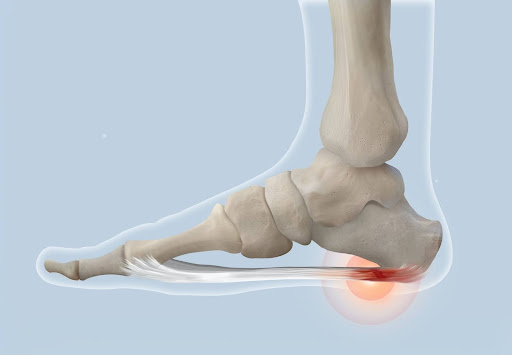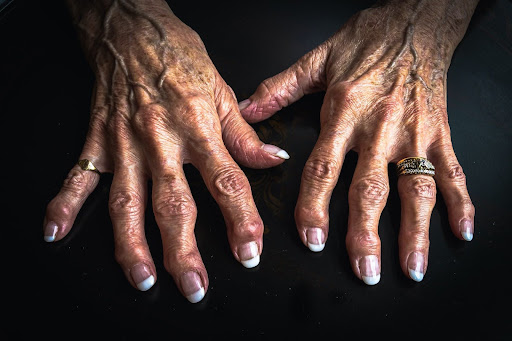
Radiation Therapy for Plantar Fasciitis
At Precision Cancer Care, we do more than treat cancer patients. Our radiation therapy can also be used to treat plantar fasciitis. If you suffer from this painful inflammation in the foot, you may be excited to learn about this newer treatment option for pain relief available at our locations in Lawrence, Chanute, and Ottawa.
Radiation Treatment for Non-Cancerous Problems
Radiation therapy is typically associated with cancer treatment. For years, radiation has helped shrink cancerous tumors by using high-energy radiation to target and destroy cancer cells. Radiation therapy, in very low doses (about 1/3rd to 1/5th of normal doses for tumors) can be very effective at targeting and killing cells responsible for the inflammation which can result in chronic arthritis and plantar fasciitis. Most healthy cells can repair themselves more effectively than cancer cells, which is why radiation therapy can selectively damage cancer tissue while sparing normal tissue. This results in very effective treatment because the feet and hands can tolerate high doses of radiation by comparison to the very low total dose required to treat arthritis effectively. Treatment is typically only 6-8 sessions which, in total is equal to approximately 1-2 standard doses of radiation.
Low-Dose Radiation Treatment for Chronic Plantar Fasciitis
However, radiation in lower doses has been shown to help alleviate inflammation helping to relieve painful symptoms of non-cancerous issues such as plantar fasciitis. Plantar fasciitis often affects individuals due to strain on the plantar fascia, the ligament connecting your heel to your toes. Traditional treatments include rest, stretching, orthotics, and corticosteroid injections, but in some cases, these methods fail to provide sufficient relief. For chronic cases, low-dose radiation therapy (LDRT) has emerged as a potential alternative.
What Causes Plantar Fasciitis?
Understanding what causes plantar fasciitis helps explain why radiation therapy can help. Plantar Fasciitis is caused by inflammation of the plantar fascia, a thick band of tissue that runs along the bottom of the foot, connecting the heel to the toes. This inflammation usually occurs when there is excessive strain or repetitive stress on the plantar fascia, leading to small tears in the tissue. Several factors can contribute to this strain:
Overuse or High-Impact Activities: Activities like running, jumping, or prolonged standing can put excessive pressure on the plantar fascia.
Foot Mechanics: Flat feet, high arches, or abnormal walking patterns can place extra stress on the plantar fascia.
Inappropriate Footwear: Shoes with inadequate arch support, thin soles, or worn-out shoes can fail to cushion the heel, leading to increased tension on the fascia.Tight Calf Muscles or Achilles Tendon: Limited flexibility in these areas can cause strain on the plantar fascia.
Obesity: Excess weight increases the load on the feet, particularly the plantar fascia, leading to more stress and damage over time.
Age: Plantar fasciitis is more common in middle-aged individuals due to the natural wear and tear on the foot’s structure over time.
These factors can cause the plantar fascia to become inflamed, leading to the sharp, stabbing heel pain characteristic of plantar fasciitis, especially when taking the first steps in the morning or after periods of inactivity.
Studies Have Shown Radiation Reduces Inflammation
Low-dose radiation has long been used in Europe for treating non-malignant inflammatory conditions like plantar fasciitis. Radiation is believed to reduce pain by calming inflammation in the affected tissue. Clinical studies have demonstrated the effectiveness of this approach. For example, in a study involving 171 patients, 67.3% of participants experienced either no or mild pain after three months of low-dose radiotherapy. At the five-year follow-up, 61.4% still reported reduced pain, with minimal mobility restrictions, making it a long-lasting solution for many patients (PubMed).
Another study comparing low-dose radiation with local steroid injections found that 88.3% of patients receiving radiotherapy experienced reduced pain, compared to just 59.4% of those treated with injections. This supports the notion that radiotherapy is not only effective but may offer better long-term results than other conventional methods (The Heel Pain Practice) (IntechOpen – Open Science Open Minds).
Low Dose Radiation Therapy Is a Safe Alternative
Low-dose radiation Therapy (LDRT) for plantar fasciitis has been shown to be a safe alternative to traditional plantar fasciitis treatments. Concerns about radiation-induced cancer or damage to surrounding tissues are not supported by current data. The radiation dose used in these treatments is similar to that of common diagnostic imaging, making it a low-risk option (BioMed Central).
 For patients with chronic plantar fasciitis unresponsive to traditional therapies, low-dose radiation therapy offers a promising alternative. With significant reductions in pain and minimal side effects, it stands as a viable option when other treatments fail. If you suffer from chronic plantar fasciitis, come see us at Precision Cancer Care. Our specialists can determine whether it’s the right option for your condition.
For patients with chronic plantar fasciitis unresponsive to traditional therapies, low-dose radiation therapy offers a promising alternative. With significant reductions in pain and minimal side effects, it stands as a viable option when other treatments fail. If you suffer from chronic plantar fasciitis, come see us at Precision Cancer Care. Our specialists can determine whether it’s the right option for your condition.

